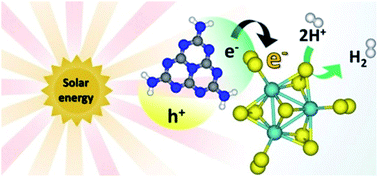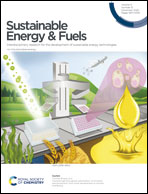Polymeric carbon nitride coupled with a molecular thiomolybdate catalyst: exciton and charge dynamics in light-driven hydrogen evolution†
Abstract
Solar hydrogen evolution from water is a necessary step to overcome the challenges of rising energy demand and associated environmental concerns. Low-cost photocatalytic architectures based on polymeric light absorbers coupled to highly efficient molecular catalysts might represent an attractive platform to address this issue. However, to-date, our mechanistic knowledge of these systems is still largely underdeveloped. In this study, a molecular molybdenum sulfide hydrogen evolving catalyst, [Mo3S13]2−, is loaded onto polymeric carbon nitride (CNx) photoabsorber by impregnation. The resulting composite shows enhanced photocatalytic activity for hydrogen evolution compared to pristine CNx under monochromatic visible light (λ = 420 nm) irradiation in the presence of sacrificial reducing agents. The light-driven dynamics of excitons and charges involved in hydrogen evolution catalysis were studied by a combination of spectroscopic (steady-state and time-resolved photoluminescence, femtosecond time-resolved transient absorption) and photoelectrochemical (open-circuit photopotential transients) methods. We demonstrate that the molecular molybdenum sulfide catalyst, at optimum loading (10 wt% nominal), improves the charge separation in the CNx absorber by facilitating the depopulation of emissive (band-edge) or non-emissive (shallow trap) states, followed by an effectively catalyzed transfer of electrons from the charge-separated state (deep trap) to protons in the solution. The results provide important insights into the complex interplay between polymeric light absorbers and molecular redox catalysts, indicating that the electron transfer to the catalyst occurs on relatively longer (nanosecond to seconds) time scale, as the catalyst had no impact on the ultrafast (sub-nanosecond) photoinduced kinetics in the CNx. These findings are of crucial importance for further development of soft-matter based architectures for solar fuels production.



 Please wait while we load your content...
Please wait while we load your content...